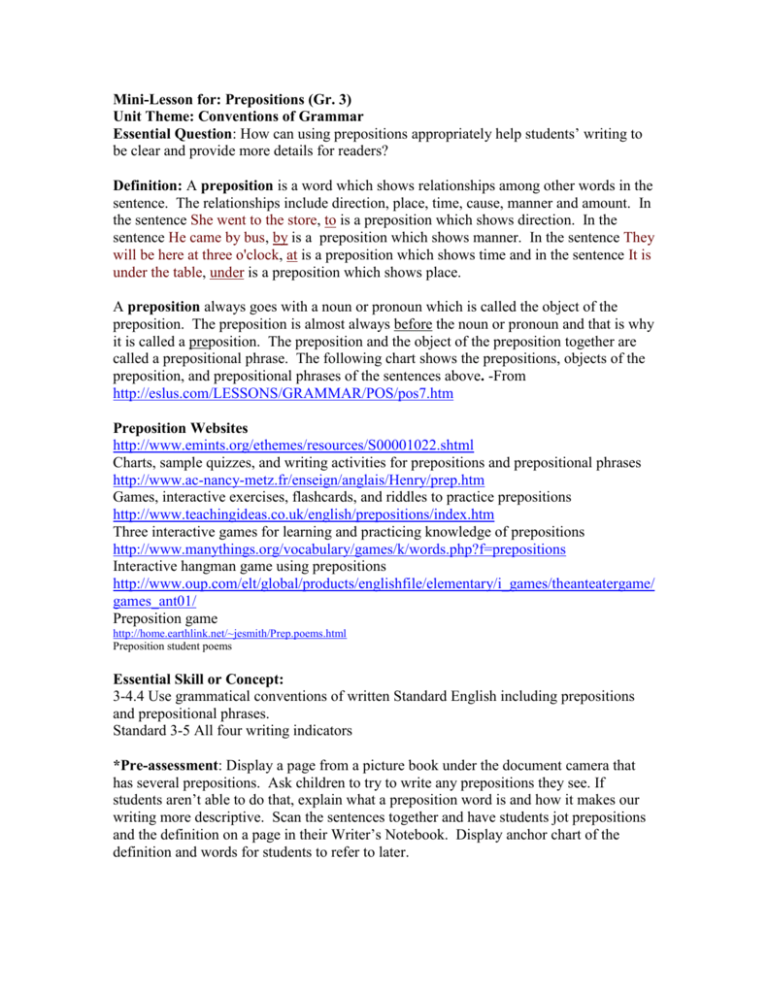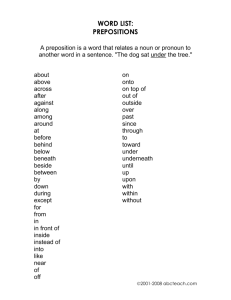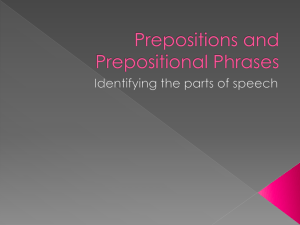Preposition Lessons Gr3
advertisement

Mini-Lesson for: Prepositions (Gr. 3) Unit Theme: Conventions of Grammar Essential Question: How can using prepositions appropriately help students’ writing to be clear and provide more details for readers? Definition: A preposition is a word which shows relationships among other words in the sentence. The relationships include direction, place, time, cause, manner and amount. In the sentence She went to the store, to is a preposition which shows direction. In the sentence He came by bus, by is a preposition which shows manner. In the sentence They will be here at three o'clock, at is a preposition which shows time and in the sentence It is under the table, under is a preposition which shows place. A preposition always goes with a noun or pronoun which is called the object of the preposition. The preposition is almost always before the noun or pronoun and that is why it is called a preposition. The preposition and the object of the preposition together are called a prepositional phrase. The following chart shows the prepositions, objects of the preposition, and prepositional phrases of the sentences above. -From http://eslus.com/LESSONS/GRAMMAR/POS/pos7.htm Preposition Websites http://www.emints.org/ethemes/resources/S00001022.shtml Charts, sample quizzes, and writing activities for prepositions and prepositional phrases http://www.ac-nancy-metz.fr/enseign/anglais/Henry/prep.htm Games, interactive exercises, flashcards, and riddles to practice prepositions http://www.teachingideas.co.uk/english/prepositions/index.htm Three interactive games for learning and practicing knowledge of prepositions http://www.manythings.org/vocabulary/games/k/words.php?f=prepositions Interactive hangman game using prepositions http://www.oup.com/elt/global/products/englishfile/elementary/i_games/theanteatergame/ games_ant01/ Preposition game http://home.earthlink.net/~jesmith/Prep.poems.html Preposition student poems Essential Skill or Concept: 3-4.4 Use grammatical conventions of written Standard English including prepositions and prepositional phrases. Standard 3-5 All four writing indicators *Pre-assessment: Display a page from a picture book under the document camera that has several prepositions. Ask children to try to write any prepositions they see. If students aren’t able to do that, explain what a preposition word is and how it makes our writing more descriptive. Scan the sentences together and have students jot prepositions and the definition on a page in their Writer’s Notebook. Display anchor chart of the definition and words for students to refer to later. *Introduced in third grade so most children probably would not have heard about prepositions before. After explaining the definition, students could scan the text in search of words that fit the definition. Mentor Text: Any text Lesson Outline: Lesson from Read Write Think found at: www.readwritethink.org/lessons/lesson_view.asp?id=34 * It is necessary to go to the website to print handouts mentioned in the three day lesson. Day 1: 30 minutes 1. 2. 3. 4. 5. 6. Read Behind the Mask by Ruth Heller to the class, allowing for student participation. Encourage students to play with the language of the text as you share the picture book. When you finish reading the book, ask students to share what they noticed about the book. Answers will vary from bright colorful illustrations to variations in font. Note their answers on the board or chart paper for reference as you discuss the text. Once students have identified such features as the use of very descriptive words or the variety in text font, shift to questions about how prepositions work in the text. Encourage students to identify the words in the text that are prepositions and how prepositions work. Pass out copies of the Prepositions Handout to help students identify the prepositions in the picture book. Take notes on their observations for reference in later sessions. Day 2: 30 minutes 1. 2. 3. Review the information on prepositions from the previous session. Share a poem from the Sample Prepositional Poems Web site with the class. After reading a sample, ask students to identify the prepositions in the poem and to discuss how the part of speech is working. Students can refer to the Prepositions Handout from the previous session as they review the sample poems. 4. Pass out copies of the Prepositional Poem Checklist, and use the questions to analyze the sample poems. 5. Repeat the process with additional example poems until you are satisfied that students understand how to identify and use the part of speech in grammatically correct ways. 6. Invite students to create their own preposition poem, using their writers notebook or the Word Mover. Depending upon experience level of students and needed accommodations, students can work in partners or independently. 7. Allow enough time for students to complete their poems in one sitting since users cannot save in this interactive. 8. Demonstrate how to create new preposition magnets that suit the needs of their poems. 9. As students work, ask them to compare their drafts to the questions on the Prepositional Poem Checklist and make adjustments as appropriate. 10. Make sure students have a printed or handwritten copy of their poem for use in the next session. Day 3: 30 minutes 1. 2. 3. 4. 5. Explain that the class will return to the poems written in the previous session and publish them in a style based on Behind the Mask. Briefly review a few key images and sections of text from the book. Ask students to think about how they can make all or part of their poem come to life in a similar fashion. Encourage students to share and discuss their ideas. Introduce the ReadWriteThink interactive Multigenre Mapper. Demonstrate how to include details in the different portions of the tool: o o o Write the title of the poem in Blank A. Write the student’s name in Blank B. Write the text of the poem in Blank C. o 6. 7. 8. Illustrate the poem in the drawing box. Remind students that their illustrations should show what one or more preposition(s) in their poem is/are doing. Suggest that students use the Prepositional Poem Checklist to evaluate their poems before printing the final copies. Have students print their poems and display them in the classroom, hallway, or lobby display case. Assessment and Reflection As students work on their poems, watch for indications that they understand the grammatical form and function of prepositions. Note how students work together, rely on their own knowledge, and consult to reference information in the classroom. Respond to students’ poems using the Prepositional Poem Checklist as a guide. From http://www.englishclub.com/grammar/prepositions-list.htm English Prepositions List- There are about 150 prepositions in English. Yet this is a very small number when you think of the thousands of other words (nouns, verbs etc). Prepositions are important words. We use individual prepositions more frequently than other individual words. In fact, the prepositions of, to and in are among the ten most frequent words in English. Here is a short list of 70 of the more common one-word prepositions. Many of these prepositions have more than one meaning. Please refer to a dictionary for precise meaning and usage. about above across after against along amid among anti around as at before behind below beneath beside besides between beyond but by concerning considering despite down during except excepting excluding following for from in inside into like minus near of off on onto opposite outside over past per plus regarding round save since than through to toward towards under underneath unlike until up upon versus via with within without









